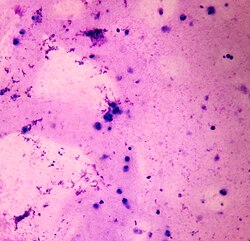Azoospermia

Editor-In-Chief: Prab R Tumpati, MD
Obesity, Sleep & Internal medicine
Founder, WikiMD Wellnesspedia &
W8MD medical weight loss NYC and sleep center NYC
| Azoospermia | |
|---|---|

| |
| Synonyms | |
| Pronounce | N/A |
| Specialty | N/A |
| Symptoms | Absence of sperm in semen |
| Complications | Infertility |
| Onset | |
| Duration | |
| Types | Obstructive azoospermia, Non-obstructive azoospermia |
| Causes | Genetic disorders, Hormonal imbalance, Obstruction |
| Risks | |
| Diagnosis | Semen analysis, Testicular biopsy |
| Differential diagnosis | |
| Prevention | |
| Treatment | Surgery, Hormone therapy, Assisted reproductive technology |
| Medication | |
| Prognosis | |
| Frequency | Affects about 1% of the male population |
| Deaths | N/A |
Pronunciation[edit]
Azoospermia is pronounced AY-zoh-oh-SPER-mee-uh)
Definition[edit]
Azoospermia is a condition in which there are no sperm in the semen when a man ejaculates.

Causes[edit]
This may be because the man does not make sperm or because the sperm is blocked from entering the semen.
Hormonal causes[edit]
Azoospermia may be caused by hormone problems also.
Genetic causes[edit]
Certain genetic conditions
Vasectomy[edit]
History of previous vasectomy or other surgery, or other conditions.
Cancer treatments[edit]
Azoospermia may also be caused by certain cancer treatments.
Infertility[edit]
Azoospermia can cause infertility or inability to produce children.
Symptoms[edit]
Azoospermia usually presents with infertility, sometimes with reduced or loss of libido.
Diagnosis[edit]
Diagnosis is through history, physical examination, semen analysis, and imaging studies as needed. Check for history of hormone/steroid therapy, antibiotics, 5-ASA inhibitors (sulfasalazine), alpha-blockers, 5 alpha-reductase inhibitors, chemotherapeutic agents, pesticides, recreational drugs (marijuana, excessive alcohol), and heat exposure of the testes, prior surgeries, or trauma etc.
Treatment[edit]
Some conditions are treatable such as pre and post testicular azoospermia while testicular azoospermia is usually permanent.
|
|
|
| Male diseases of the pelvis and genitals | ||||||
|---|---|---|---|---|---|---|
|
Ad. Transform your life with W8MD's Budget GLP-1 injections from $75


W8MD offers a medical weight loss program to lose weight in Philadelphia. Our physician-supervised medical weight loss provides:
- Weight loss injections in NYC (generic and brand names):
- Zepbound / Mounjaro, Wegovy / Ozempic, Saxenda
- Most insurances accepted or discounted self-pay rates. We will obtain insurance prior authorizations if needed.
- Generic GLP1 weight loss injections from $75 for the starting dose.
- Also offer prescription weight loss medications including Phentermine, Qsymia, Diethylpropion, Contrave etc.
NYC weight loss doctor appointmentsNYC weight loss doctor appointments
Start your NYC weight loss journey today at our NYC medical weight loss and Philadelphia medical weight loss clinics.
- Call 718-946-5500 to lose weight in NYC or for medical weight loss in Philadelphia 215-676-2334.
- Tags:NYC medical weight loss, Philadelphia lose weight Zepbound NYC, Budget GLP1 weight loss injections, Wegovy Philadelphia, Wegovy NYC, Philadelphia medical weight loss, Brookly weight loss and Wegovy NYC
|
WikiMD's Wellness Encyclopedia |
| Let Food Be Thy Medicine Medicine Thy Food - Hippocrates |
Medical Disclaimer: WikiMD is not a substitute for professional medical advice. The information on WikiMD is provided as an information resource only, may be incorrect, outdated or misleading, and is not to be used or relied on for any diagnostic or treatment purposes. Please consult your health care provider before making any healthcare decisions or for guidance about a specific medical condition. WikiMD expressly disclaims responsibility, and shall have no liability, for any damages, loss, injury, or liability whatsoever suffered as a result of your reliance on the information contained in this site. By visiting this site you agree to the foregoing terms and conditions, which may from time to time be changed or supplemented by WikiMD. If you do not agree to the foregoing terms and conditions, you should not enter or use this site. See full disclaimer.
Credits:Most images are courtesy of Wikimedia commons, and templates, categories Wikipedia, licensed under CC BY SA or similar.
Translate this page: - East Asian
中文,
日本,
한국어,
South Asian
हिन्दी,
தமிழ்,
తెలుగు,
Urdu,
ಕನ್ನಡ,
Southeast Asian
Indonesian,
Vietnamese,
Thai,
မြန်မာဘာသာ,
বাংলা
European
español,
Deutsch,
français,
Greek,
português do Brasil,
polski,
română,
русский,
Nederlands,
norsk,
svenska,
suomi,
Italian
Middle Eastern & African
عربى,
Turkish,
Persian,
Hebrew,
Afrikaans,
isiZulu,
Kiswahili,
Other
Bulgarian,
Hungarian,
Czech,
Swedish,
മലയാളം,
मराठी,
ਪੰਜਾਬੀ,
ગુજરાતી,
Portuguese,
Ukrainian


